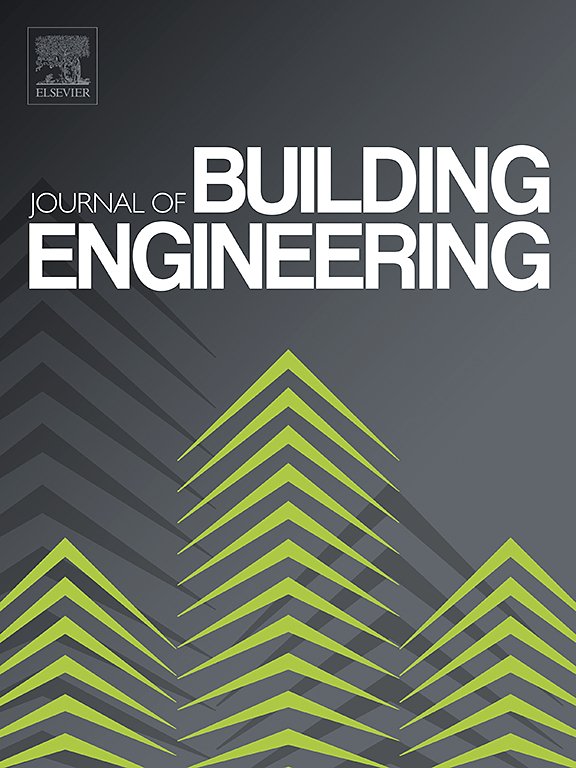高温条件下工程土工聚合物复合材料(EGC)的微观结构和残余强度特性
IF 6.7
2区 工程技术
Q1 CONSTRUCTION & BUILDING TECHNOLOGY
引用次数: 0
摘要
本研究探讨了高温对工程土工聚合物复合材料(EGC)的微观结构和残余抗压强度特性的影响。本研究的重点是工程土工聚合物复合材料的性能和耐久性,旨在实现可持续的建筑实践。拟议的研究通过在 EGC 中使用钢纤维(SF)作为主要加固材料填补了知识空白,特别是涉及粉煤灰(FA)、碱性氧气炉(BOF)炉渣和铁矿尾矿(IOT)的组合。通过制备立方体试样(50 毫米)来评估 EGC 在高温条件下的残余特性,试样以粉煤灰和碱性氧炉炉渣为主要前体,以 IOT 部分替代传统的细骨料(M-砂),并以黄铜涂层 SF 作为离散加固材料。试样在马弗炉中以 25、200、400、600、800 和 1000 ℃ 六种不同的温度水平暴露在高达 1000 ℃ 的温度下。暴露后,试样在环境中固化,然后通过扫描电子显微镜(SEM)分析测试孔隙结构分布、残余强度特性和微观结构特征。实验结果表明,尽管前驱体、IOT 和 SF 的组合各不相同,但 EGC 混合材料在任何暴露温度下都不会发生爆炸性劣化或剥落。此外,随着暴露温度的升高,抗压强度降低,而应变能力增强,这表明 EGC 混合料的刚度增加。值得注意的是,即使在 1000 °C 的温度下,SF 仍能保持结构的完整性,这与观察到的微观结构行为一致。这表明拟议的 EGC 具有优异的耐高温性能和更强的应变硬化能力。总之,这项研究为了解基于 FA:BOF:IOT 的 EGC 的残余特性和微观结构特征提供了宝贵的见解,凸显了其作为可持续耐火建筑材料的潜力。研究成果极大地丰富了有关 EGC 及其在高温环境中应用的现有知识。本文章由计算机程序翻译,如有差异,请以英文原文为准。
Microstructure and residual strength properties of engineered geopolymer composites (EGC) subjected to high temperatures
This study investigates the effects of high temperature on the microstructure and residual compressive strength properties of engineered geopolymer composites (EGC). The importance of this study focusses on the performance and durability of EGC, aiming towards sustainable construction practices. The proposed study fills the knowledge gap by the use of steel fibers (SF) as primary reinforcement in EGC, specifically involving a combination of Fly Ash (FA), Basic Oxygen Furnace (BOF) slag, and Iron Ore Tailings (IOT). The residual properties of EGC under high-temperature conditions were assessed by preparing cube specimens (50 mm) involving FA and BOF slag as primary precursors, with IOT as a partial replacement to conventional fine aggregate (M-sand) and brass-coated SF as discrete reinforcement. The specimens were exposed to temperatures up to 1000 °C in a muffle furnace in six different levels: 25, 200, 400, 600, 800, and 1000 °C. Post-exposure, the specimens were ambient cured prior to testing of pore structure distribution, residual strength properties, and microstructural characteristics involving scanning electron microscopy (SEM) analysis. The experimental findings show that, despite various combinations of precursors, IOT and SF, no explosive deterioration or spalling occurred in EGC mixes at any level of exposure. Also, as the exposure temperature increased, the compressive strength decreased while the strain capacity enhanced, denoting an increase in the stiffness of the EGC mixes. Notably, the SF maintained its structural integrity even at 1000 °C, which was consistent with the observed microstructural behavior. This indicates the proposed EGC exhibits excellent resistance to elevated temperatures and enhanced strain-hardening capacity. Overall, this research provides valuable insights into the residual properties and microstructural characteristics of FA: BOF: IOT-based EGC, highlighting its potential as a sustainable and fire-resistant building material. The outcomes contribute significantly to the existing knowledge on EGC and its application in environments exposed to high temperatures.
求助全文
通过发布文献求助,成功后即可免费获取论文全文。
去求助
来源期刊

Journal of building engineering
Engineering-Civil and Structural Engineering
CiteScore
10.00
自引率
12.50%
发文量
1901
审稿时长
35 days
期刊介绍:
The Journal of Building Engineering is an interdisciplinary journal that covers all aspects of science and technology concerned with the whole life cycle of the built environment; from the design phase through to construction, operation, performance, maintenance and its deterioration.
 求助内容:
求助内容: 应助结果提醒方式:
应助结果提醒方式:


